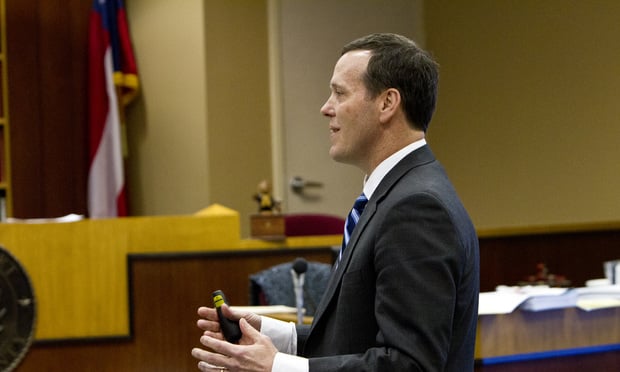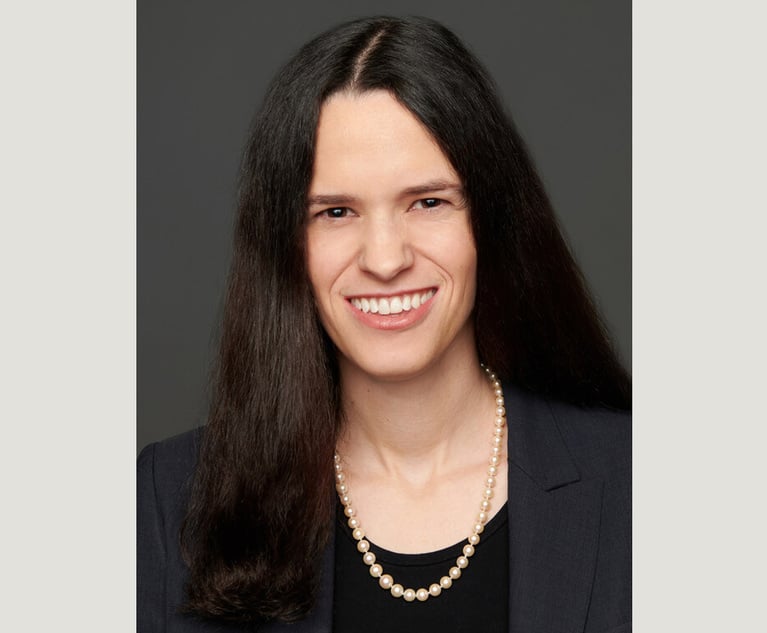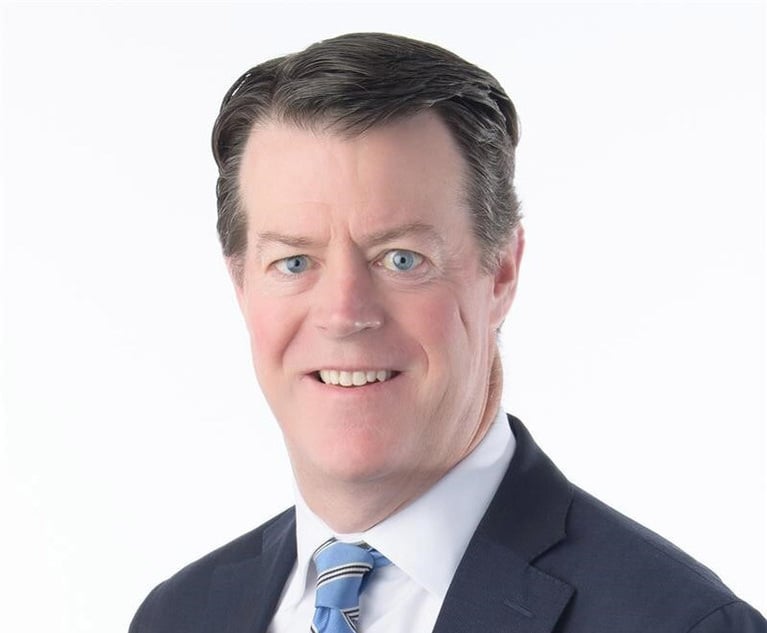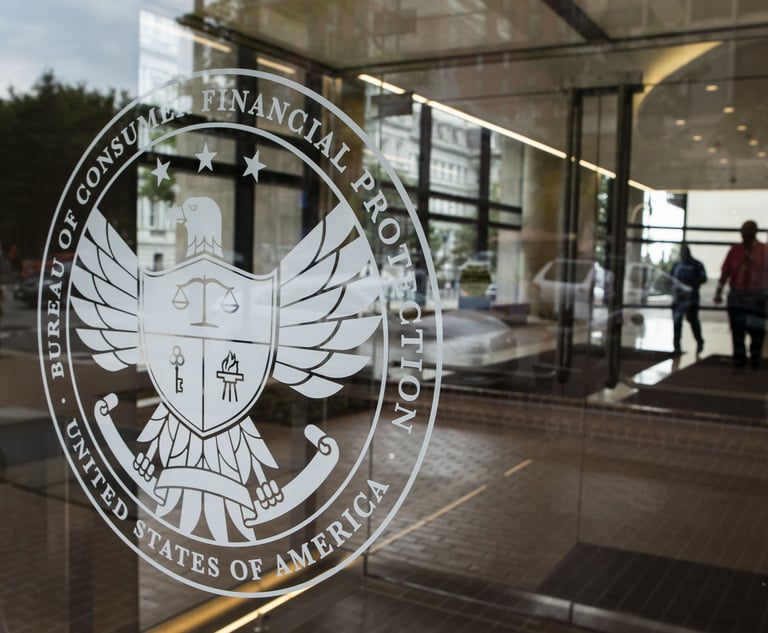Incoming! Insurance Defense Lawyers Talk 'Nuclear Verdicts'
Lawyers and insurance executives say the surge of surprisingly high awards subject to social inflation—also known as "nuclear verdicts"—is not a new phenomenon.
May 14, 2020 at 04:15 PM
13 minute read
 Daniel "Dan " Huff gives closing arguments in a med-mal retrial in Cobb County State Court, Georgia,cin 2014. (Photo: John Disney/ALM)
Daniel "Dan " Huff gives closing arguments in a med-mal retrial in Cobb County State Court, Georgia,cin 2014. (Photo: John Disney/ALM)
There's no doubt that recent years have seen a rise of jury awards across the tort claim spectrum, including a $32 million Ohio verdict that left Dentons reeling in shock.
Lawyers and insurance executives say the surge of surprisingly high awards subject to social inflation—also known as "nuclear verdicts"—is not a new phenomenon.
Jim Lynch, chief actuary and senior vice president with Insurance Information Institute, pointed to figures showing that since 2003 the median cost of single-fatality accident rose from $2.1 million to $5.1 million in 2019, according to a study by insurance research company Advisen.
"It was about 2018 or 2019 that 'social inflation' began to catch fire, but if you look at the numbers, the phenomena goes back beyond that," said Lynch. "What we find is that increasing jury awards [and] settlement costs on injuries of a tortious nature have been rising precipitously for several years."
Related story: 'Anger' and 'Defensiveness' Cost Insurance Companies Millions: 3 Tips for Avoiding a Jury's Punishment
The trend started in commercial auto insurance in about 2015 and spread to other insurance lines over the next couple of years, he said.
"What we think happened in commercial auto was that there were changes in commercial trucking regulations … and the plaintiffs bar found a way to systematically start getting settlements in $5 million, $8 million range; a way to basically generate revenue while generating more cases," said Lynch. "They discovered that, instead of blaming the individual driver, they could blame the employer or company [by saying] he was overworked or insufficiently trained or something."
The tactic allowed landlords, hospitals and commercial establishments to be blamed for failing to institute or follow policies that should have prevented a plaintiff's harm, he said.
"That increases your verdict size, because they've got deep pockets," Lynch said.
"Another contributing factor is litigating financing, which has become an investment class just like stocks and bonds," he said. "You have venture capitalists, sophisticated investors, putting trillions of dollars into litigation financing, allowing cases that may have been worth a half-million dollars to go much higher."
Lynch said that, in addition to legal tactics, another possible explanation is societal.
"Institutions across the board are held in less regard than they were years ago," he said. "Even before the global pandemic there was this despair: Greater income inequality, government dysfunction."
Delve deeper: Stemming the tide of social inflation
Jurors "try to apply the law correctly," he said. "They go into a courtroom and feel like they can make a difference. There's a notion that there's an unacceptable amount of what they consider injustice in the world."
Even judicial circuits and jurisdictions once considered relatively safe venues have handed out eye-popping victories to plaintiffs as of late. In Georgia, a jury in Columbus last year awarded $125 million in the death of man who died at The Ralston, a former luxury hotel converted into a senior care home. The next month, another jury there decided $280 million was appropriate compensation for a woman killed along with four family members when a tractor-trailer hit their minivan head-on.
Last December a jury in rural Greene County awarded nearly $15 million to a teenager who almost lost a leg in a motocross accident, and a Camilla jury penciled in $18 million last year for a man badly injured when a dumptruck rear-ended the tractor he driving.
That award was thrown out last month by the Georgia Court of Appeals, which ruled the plaintiff's lawyers improperly crossed the line with inflammatory statements during closing arguments.
Related story: Tort Reform Capping Nuclear Insurance Verdicts Stymied by COVID-19
While virtually none of the megaverdicts are ever actually paid in full—most settle posttrial, pending appeal, after they've survived appellate review, or on remand for new trial. They still serve as enormous bargaining chips, said Holland & Knight partner Laurie Webb Daniel, who leads the firm's appellate team and Atlanta litigation group, who argued and won the reversal of last month's $18 million verdict at the Georgia Court of Appeals.
"I'm seeing a disregard for the rules of evidence from the plaintiffs' side to get a verdict as high as possible which, regardless of reversible error, is so high they try to leverage a very high settlement," said Daniel, who has led the appeals of multiple other multimillion-dollar verdicts and is listed among the counsel for three-dozen past or pending appeals at the Georgia Supreme Court.
"For example," said Daniel, "plaintiffs lawyers are not supposed to get into anything that would go to a punitive aspect of the case when it's the compensatory phase—that's supposed to be in the punitive damages phase, if it gets there."
The tactic is part of "Reptile theory," said Daniel, a reference to the 2009 best-selling plaintiffs bar tutorial by Don Keenan and David Ball, which relies on appealing to jurors' instinctive fear of danger.
"The tactic is to demonize the defendant, no matter who it is, so the jury wants to punish them and send a message," she said.
Daniel said her first encounter with the recent wave of nuclear verdicts came in 2013 when a Cobb County jury returned a $40.2 million verdict in the case of a collision involving a tractor-trailer that killed a man and injured his wife.
"The Landstar case was the largest wrongful death verdict at the time; it included a $28 million wrongful death verdict plus $11 million in emotional distress for the widow," said Daniel. "It was shocking at the time. Then the Six Flags case came along: $35 million (for a young man paralyzed after a gang attack near the amusement park's gates)."
That 2013 case also settled confidentially, but only after the verdict was thrown out by the Court of Appeals, then partially reinstated with remand for a new trial on apportionment between the park and the attackers, who only bore 8% of the liability according to the jury.
"Then things started picking up," said Daniel. "I remember how shocked people were. Now I have people asking me, 'it's a $5 million case, can't we make it go away.'"
"My mantra is that, when the measure of damages is the enlightened conscience of the jury, it's imperative for the trial court to adhere to this rule and enforce the rules of fair play, codified in Georgia law, that prohibit certain types of evidence and prohibit improper closing evidence," she said.
Daniel said she thinks several issues are at play.
"One, plaintiffs lawyers have become emboldened because they're getting away with with it," she said. "Two, I think advertising has a role: Jurors are seeing billboards saying insurers have all this money they can get. They think it's free money, but it's not."
"And three, I think the jury pool has been desensitized," Daniel said. "They hear about these big verdicts and think that's a normal outcome."
As an appellate specialist, Daniel said there are some things defense lawyers can do pre- and post-verdict.
"Make use of motions in limine, try to think of absolutely everything you can to preserve error," she said. "Make sure to preserve any argument that's being made; move for a directed verdict."
Daniel said one key plaintiffs' tool is to stretch the "foreseeability" concept—that a defendant should have foreseen and acted to prevent an incident—but that recent appellate decisions have largely rejected those tactics.
She pointed to a 2016 Fulton County jury award of $3.7 million to a woman molested by a dental technician while under sedation, with none of the fault apportioned to the molester.
On appeal, the Georgia Supreme Court reversed, ruling the trial court should have granted the defendant dental practice's motion for a directed verdict on the grounds that the assault did not meet the legal foreseeability test.
Daniel said some insurers have responded to increasingly forceful plaintiffs tactics by taking more cases to trial.
"Some insurance people higher up talk pretty tough," she said. "What I'm seeing is some of them recognizing that plaintiffs counsel can be pretty aggressive, and that's why in recent years I've been brought in at the trial level more and more, sort of a safety net."
Defense trial lawyers Dan Huff and Scott Bailey of Atlanta-based Huff Powell & Bailey agreed that a consistent element in oversized awards are efforts to appeal to jurors emotions.
The Reptile approach "is just one of several things plaintiffs have used and studied to present cases differently than they used to," he said. "Cases used to be tried on sympathy for the plaintiff a lot, and sometimes we'd get a big verdict but not these nuclear awards. It's anger driving them now."
The pair said jurors have told them after trials that they were upset with the defendants and meant the verdict to send a message.
"It's our job to defuse that anger, to recognize the potential up front and address it by talking about damages head-on, early in the trial," said Huff. "We're talking about damages a lot more than we have in the past, and jurors seem to expect that from us. Historically, we tried our cases on liability and causation."
"We need to do more than retain experts to discuss life-care plans or economic reports, since a big portion of these nuclear verdicts is non-economic damages," Huff said.
Rather than challenge the plaintiffs' figures, "we've just asked jurors not to consider damages at all," Bailey said.
"We've been doing that for a few years now, but I think the defense bar has been a little bit behind the plaintiffs bar," said Bailey. "Now we talk about accepting responsibility, even when you're denying liability."
When defending third-party liability cases, such as a shooting at an apartment complex or grocery store, the defense lawyers said judges' decisions allowing plaintiffs lawyer to tell jurors that any award will be reduced by the amount apportioned to the at-fault party—usually a criminal with no resources—is a significant factor in premises liability cases.
They also said that—although the "Golden Rule" prevents lawyers form asking jurors to put themselves in the shoes of the plaintiff—it's sometimes hard to keep that from occurring.
"I think there's a component of defending those cases where there's there's no acceptance of responsibility, where everything is contested by the defendants, which is seen as unreasonable," Huff said.
"It's easier for a juror to get angry at a corporation," said Huff. "The perception is that they make so much money off all of us, but then they won't spend money on an additional safety item like a security guards or a camera. Then those cases are exploited to make jurors angry."
They also said there may be a generational element to mounting verdicts.
"One thing people look at with so-called social inflation are the millennials. They're seen as a driving force behind these nuclear verdicts," Huff said.
Bailey cited an example of a verdict handed down in 2016 the day after Donald Trump was elected president.
"A couple of jurors mentioned that the mood in the jury room was one of frustration and anger," he said. "$30 million in Gwinnett County."
While laying the trend at the feet of millennials may be a bit "simplistic and overstated," Bailey said it did seem to be a factor.
They said the COVID-19 outbreak may change the way jurors look at cases, particularly medical malpractice suits against pharmaceutical companies and health care providers.
"Generally, I think jurors will see that hospitals and medical providers are important, not just necessary evils," Huff said.
Like Daniel, the lawyer said insurers have hardened their stance on settling, and are sending more cases to trial.
"The message we've been given is that we've got to try cases," said Bailey. "It seems paradoxical in an environment of bigger verdicts … but we've also been asked to aggressively identify potentially high damages cases and mark them for possible early resolution if the facts warrant it."
A partner in a large Atlanta-based defense firm, who asked that he not be identified, said at least part of problem is poor handling of cases in the early stages by insurers.
"We almost always handle cases for the excess [coverage] carriers," he said. "It's our experience that, for a lot of these primary carriers, they don't want to pay their lawyers anything, and they don't let them handle cases like they should. They get paid low rates, they don't get to use the experts they like to. Who wants to do it?"
"Ten, 12 years ago, when the insurance industry became more concerned about costs rather than quality, it seriously handicapped the defense bar," he said.
Declining to identify any carrier by name, he said, "when we get a case and we know the primary carrier is XYZ, we know the case is going to be a mess."
"It's not because their lawyers aren't good lawyers" he said. "They're just working under very difficult circumstances."
Read more:
'The Whites of Their Eyes': Lawyers Say Litigating With Insurers Becomes a Game of Chicken
These Lawyers Won Some of Biggest Verdicts and Settlements in the Nation. What's the Magic Sauce?
This content has been archived. It is available through our partners, LexisNexis® and Bloomberg Law.
To view this content, please continue to their sites.
Not a Lexis Subscriber?
Subscribe Now
Not a Bloomberg Law Subscriber?
Subscribe Now
NOT FOR REPRINT
© 2025 ALM Global, LLC, All Rights Reserved. Request academic re-use from www.copyright.com. All other uses, submit a request to [email protected]. For more information visit Asset & Logo Licensing.
You Might Like
View All
In-House Moves of the Month: Boeing Loses Another Lawyer, HubSpot Legal Chief Out After 2 Years
5 minute read
After Regime Change, Syria Remains Liable in US Federal Courts for Alleged Assad-Era Terrorism Support
3 minute read
Carrier Legal Chief Departs for GC Post at Defense Giant Lockheed Martin

Law Firms Mentioned
Trending Stories
- 1Cleary Nabs Public Company Advisory Practice Head From Orrick in San Francisco
- 2New York Environmental Legislation in 2024
- 3Cravath Hires Paul Weiss Antitrust Co-Chair
- 4Contract Technology Provider LegalOn Launches AI-powered Playbook Tool
- 5Court of Appeals Provides Comfort to Land Use Litigants Through the Relation Back Doctrine
Who Got The Work
J. Brugh Lower of Gibbons has entered an appearance for industrial equipment supplier Devco Corporation in a pending trademark infringement lawsuit. The suit, accusing the defendant of selling knock-off Graco products, was filed Dec. 18 in New Jersey District Court by Rivkin Radler on behalf of Graco Inc. and Graco Minnesota. The case, assigned to U.S. District Judge Zahid N. Quraishi, is 3:24-cv-11294, Graco Inc. et al v. Devco Corporation.
Who Got The Work
Rebecca Maller-Stein and Kent A. Yalowitz of Arnold & Porter Kaye Scholer have entered their appearances for Hanaco Venture Capital and its executives, Lior Prosor and David Frankel, in a pending securities lawsuit. The action, filed on Dec. 24 in New York Southern District Court by Zell, Aron & Co. on behalf of Goldeneye Advisors, accuses the defendants of negligently and fraudulently managing the plaintiff's $1 million investment. The case, assigned to U.S. District Judge Vernon S. Broderick, is 1:24-cv-09918, Goldeneye Advisors, LLC v. Hanaco Venture Capital, Ltd. et al.
Who Got The Work
Attorneys from A&O Shearman has stepped in as defense counsel for Toronto-Dominion Bank and other defendants in a pending securities class action. The suit, filed Dec. 11 in New York Southern District Court by Bleichmar Fonti & Auld, accuses the defendants of concealing the bank's 'pervasive' deficiencies in regards to its compliance with the Bank Secrecy Act and the quality of its anti-money laundering controls. The case, assigned to U.S. District Judge Arun Subramanian, is 1:24-cv-09445, Gonzalez v. The Toronto-Dominion Bank et al.
Who Got The Work
Crown Castle International, a Pennsylvania company providing shared communications infrastructure, has turned to Luke D. Wolf of Gordon Rees Scully Mansukhani to fend off a pending breach-of-contract lawsuit. The court action, filed Nov. 25 in Michigan Eastern District Court by Hooper Hathaway PC on behalf of The Town Residences LLC, accuses Crown Castle of failing to transfer approximately $30,000 in utility payments from T-Mobile in breach of a roof-top lease and assignment agreement. The case, assigned to U.S. District Judge Susan K. Declercq, is 2:24-cv-13131, The Town Residences LLC v. T-Mobile US, Inc. et al.
Who Got The Work
Wilfred P. Coronato and Daniel M. Schwartz of McCarter & English have stepped in as defense counsel to Electrolux Home Products Inc. in a pending product liability lawsuit. The court action, filed Nov. 26 in New York Eastern District Court by Poulos Lopiccolo PC and Nagel Rice LLP on behalf of David Stern, alleges that the defendant's refrigerators’ drawers and shelving repeatedly break and fall apart within months after purchase. The case, assigned to U.S. District Judge Joan M. Azrack, is 2:24-cv-08204, Stern v. Electrolux Home Products, Inc.
Featured Firms
Law Offices of Gary Martin Hays & Associates, P.C.
(470) 294-1674
Law Offices of Mark E. Salomone
(857) 444-6468
Smith & Hassler
(713) 739-1250








